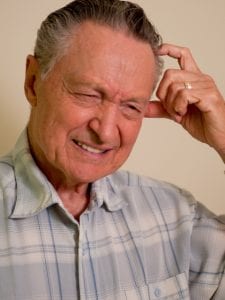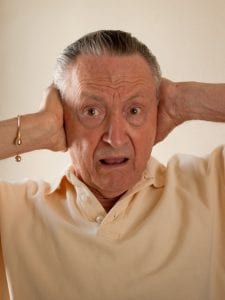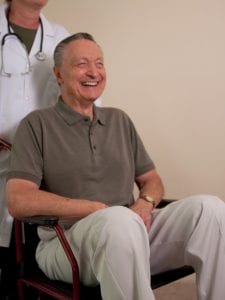Welcome to the educational program Dementia, Delirium, and Depression: Similarities, Differences, and Treatments. Delirium and depression are commonly seen in those with dementia, but it can be difficult to distinguish the three conditions because they can have similar symptoms. This program will help you understand the similarities and differences between dementia, delirium, and depression, and the major treatments for them.
. . .
This is Lesson 1 of The Alzheimer’s Caregiver. You may view the topics in order as presented, or click on any topic listed in the main menu to be taken to that section. We hope that you enjoy this program and find it useful in helping both yourself and those you care for.
There are no easy answers when it comes to the care of another, as every situation and person is different. In addition, every caregiver comes with different experiences, skills, and attitudes about caregiving. Our hope is to offer you useful information and guidelines for caring for someone with dementia, but these guidelines will need to be adjusted to suit your own individual needs.
Remember that your life experiences, your compassion, and your inventiveness will go a long way toward enabling you to provide quality care. Let’s get started.
Prefer to listen to this lesson? Get started by clicking the Play button below.
Dementia

Dementia is a descriptive umbrella term for the long term loss of mental functions, such as memory, thinking and reasoning, caused by various forms of brain damage and diseases. The common underlying element is damage to and loss of brain cells. This damage and loss severely affect the person’s ability to use good judgment, make sound decisions, communicate needs, and carry out activities of daily living. It can affect language skills, recognition, perception, personality, emotional responses, and social behavior.
Some common symptoms of dementia include confusion about the date or time of day, repeatedly asking the same questions, inability to follow directions, getting lost or disoriented in familiar places, lack of recognition or confusion about familiar people, difficulty with routine tasks such as paying the bills, personality changes, neglect of personal safety, hygiene, and nutrition, and difficulty with coordination or balance.
Dementia can be irreversible as is the case with Alzheimer’s disease, or it can be partially or fully reversible if it is caused by a medical condition that is treatable as in the case of some forms of brain, heart, or lung disease. If you or someone you care for has symptoms of dementia, such as confusion, memory difficulties, and impaired function, be sure to consult a physician because the cost may be treatable or it may be possible to slow the progression of the dementia.
Delirium

Delirium is a temporary state of confusion and disorientation that typically develops quickly, within hours to a couple of days. This is referred to as an acute or abrupt onset. Symptoms usually fluctuate, and often include reduced awareness of surroundings and events, perceptual distortions, such as delusions and hallucinations, confused and sometimes loud and belligerent speech, disorganized thought processes that can produce bizarre behavior, and fluctuating level of consciousness. Symptoms usually worsen late in the day, which is known as sundowning. Delirium can last hours or even weeks until the cause is determined and treated.
Delirium is a descriptive syndrome, or a condition, as it has many causes. It is basically a medical condition that has resulted in a toxic state in the brain. Because it represents an acute and severe disturbance of brain functioning, it is considered a medical emergency requiring immediate attention. It can be caused by high fever, infections, medications, dehydration, toxins in the system (such as alcohol), and severe constipation or a fecal infection. It can be worsened by unfamiliar surroundings or people.
It is not unusual for someone with dementia to develop delirium. If a person with dementia has been stable and reasonable in behavior then suddenly changes behavior or mental functioning in a dramatic way, it is possible that she or he is experiencing delirium. The sudden change is usually because something has happened to upset the body’s equilibrium, causing the person to become more confused or frightened. Understanding this, the first response to delirium should be to provide calm reassurance and make sure that the person and caregiver are safe. Then it is important to find out what is causing the delirium and treat it.
Depression

Depression is a mental disorder that typically presents with depressed mood, loss of interest or pleasure, lack of energy or concentration, feelings of worthlessness, guilt, helplessness, or hopelessness, irritability, disturbed sleep and appetite, and thoughts of death.
These symptoms can become chronic or recurrent and significantly affect the person’s health and ability to function. People who are depressed tend to stay in bed or sit around, engaging IN less and less physical activity. For an older person, this lack of activity can contribute to stiffness of joints, loss of strength and flexibility, and loss of general mobility, leading to dependence on wheelchairs and other assistance.
Research has shown that depression also affects the immune system. This means that depressed people are more vulnerable to infections and poor health. This is especially true of older persons who already have lowered immune function and are high risk for lung and urinary tract infections. Older people are especially vulnerable to depression, because of the many losses the experience. They may face loss of loved ones, careers, physical health, independence, mobility, vision, hearing, function, and appearance. The loss of loved ones, friends, and acquaintances can lead to loss of social identity and support networks. Other losses that may cause depression in the elderly include loss of abilities such as driving, shopping, and cooking. These changes affect the person’s self image and sense of independence. Aging also brings about physiologic changes, such as alterations in metabolism and brain chemistry, that contribute to fatigue and slowing of thought processes.
These changes can be difficult for someone to face. Depression and the elderly can present with similar symptoms of dementia. Depressed individuals may have sleep disturbances, such as difficulty falling asleep, nighttime wakening and wandering, and daytime napping. They may neglect their personal hygiene and lose interest in eating and drinking, and similar to dementia, memory concentration and social behavior may be affected.
Because depression and dementia have many symptoms in common. It is important to get a thorough evaluation by a health care professional to distinguish the two as treatments are prognosis are very different depending on the illness.
Understanding the Differences Between Dementia, Delirium, and Depression

Dementia, delirium, and depression have many similar symptoms. They have different causes and different treatments. Giving treatment for the wrong condition could have negative and even dangerous consequences for the person, so it is extremely important to correctly diagnose the cause of the symptoms.
An experienced healthcare professional should evaluate the person and prescribe the treatment. However, we will present a brief comparison of some important signs and symptoms that will help you to distinguish one condition from another.
Onset

The most prominent difference is in the onset of the conditions, which refers to when and how rapidly the symptoms and signs appear. Whereas delirium typically has an acute or abrupt onset over a few hours to a couple of days, depression typically evolves over weeks to months and dementia symptoms generally develop over many months to years.
Attention and Concentration

All three conditions affect the person’s attention and concentration, but there are some differences in the character of this effect.
A person with delirium may simply not be capable of paying attention or concentrating, and overall thinking is very disorganized. This can fluctuate from time to time.
In dementia, the ability to pay attention and concentrate is impaired, but if the caregiver faces the person, gets her or his attention, and stays engaged, the person is usually able to focus and concentrate on a task, such as eating or bathing.
In depression, attention and concentration or poor because those with depression often do not pay attention to their surroundings or to what people are saying. They may not be able to recall conversations, directions, or events. When a person with depression has trouble remembering things. It is referred to as pseudo dementia, which is not a true dementia. The memory problems associated with depression are most likely caused by poor attention and concentration
Apathy

Apathy can be seen with both dementia and depression, and can present as indifference, diminished initiative, or persistence in an activity, lack of interest, low social interaction, blunted emotional response, and lack of insight.
One of the subtle differences between the apathy seen in dementia versus depression is that a person with dementia who is apathetic is less likely to show emotions and social engagement, whereas a depressed person is more likely to show facial expressions and engage socially. A professional who is familiar with the symptoms of dementia and depression should be consulted to sort this out as the treatment though similar have some important differences.
Perceptual Distortions

A perceptual distortion is a misinterpretation of physical stimuli. When someone sees, hears, tastes, smells, or physically feels things that are not there, this is called a hallucination. When someone mistakes something for something else, such as a shadow for a person, this is called an illusion. A strongly held false belief is called a delusion.
Perceptual distortions are commonly observed with delirium and dementia, but much less so with depression. However, if it is a very severe or psychotic depression, the person may have delusions and hallucinations. In the case of delirium, affected individuals will have gross distortions of visual and audio stimuli, and can become very frightened, striking out at what they may perceive as ghosts, wild animals, thieves, or aliens. People with dementia will also have perceptual distortions from time to time, causing fright, though the reaction is not as acute or sudden. People with dementia are also typically more easily reassured than someone with delirium.
Communication

Speech is a critical function of a specific site in the frontal lobe of the brain called Broca’s area. Delirium is an acute brain syndrome that causes general impairments of many brain functions, including speech and understanding. So a person suffering from delirium can suddenly develop difficulty speaking or saying coherent things with nonsense words and syllables, or use abusive language.
In dementia, there’s an impairment of both using and understanding language, but it develops gradually over weeks and months of the illness.
Though people with depression may have slow and sparse speech, they will be able to understand and communicate adequately if the caregiver is patient.
Course

How the conditions change over time also differ. A person with delirium can have frequent fluctuations in the degree of alertness, confusion, and orientation, as well as other symptoms.
Delirium can have a short course if the cause is found and treated.
In contrast, some forms of dementia can have no cure. In cases such as Alzheimer’s disease, there is usually a gradual decline of memory, recognition, speech, and self-care function over a period of months to years. Although there can be fluctuations from time to time, some forms of dementia can be partially or fully reversed with proper treatment and rehabilitation.
Depression can have a similar presentation to dementia and delirium, with symptoms such as memory impairment, poor attention and concentration, and irritability, but these symptoms are usually less dramatic than those seen with dementia and delirium. Oftentimes, a depressed person may just seem quieter than usual, complain of fatigue, and be disinterested in food or the surroundings. Symptoms of depression typically do not fluctuate very much. Fortunately, depression—even the depression caused by dementia—can be treated with a variety of drug and non-drug treatments.
Dementia Treatment
Treatment for dementia varies with the specific disorder or cause of the dementia. Therefore, treatment begins with diagnosing the underlying disease where possible.
The underlying causes of some forms of dementia—including nutritional, hormonal, tumor-caused, and drug-related—may be reversible to some extent. Treatment for stroke-related dementia begins by minimizing the risk of further strokes through smoking cessation, aspirin therapy, and treatment of hypertension, for instance.

Because there is no cure for Alzheimer’s disease, the goal of treatment is to control the symptoms of dementia and slow disease progression. The disease typically progresses over an average period of eight to twelve years after onset of symptoms, or an average of four to eight years after diagnosis of the disease. Symptoms of dementia may be treated with a combination of medication, behavior therapy, psychotherapy, and environmental modifications.
Two classes of drugs, cholinesterase inhibitors and NMDA antagonists are currently prescribed for the treatment of Alzheimer’s disease. The cholinesterase inhibitors include donepezil (trade name Aricept®), rivastigmine (trade name Exelon®), and galantamine (trade name Razadyne®). Donepezil is the only treatment approved by the FDA to treat all stages of Alzheimer’s disease—mild, moderate and severe. It may also delay the onset of Alzheimer’s disease in people who have mild cognitive impairment (MCI) for about a year. Rivastigmine and galantamine are used to treat mild to moderate but not severe Alzheimer’s disease.
Cholinesterase inhibitors increase the level of acetylcholine, a chemical in the brain used for memory and learning. In Alzheimer’s disease, the brain makes less acetylcholine. By slowing the breakdown of acetylcholine, cholinesterase inhibitors can improve or delay cognitive and functional impairments in about half of the people who take them. Possible side effects of cholinesterase inhibitors include diarrhea, vomiting, nausea, fatigue, and insomnia. Because of varying response, side effects, and possible interactions with other medications, doctors may try different cholinesterase inhibitors until the most effective one is found for each individual.
Dementia Treatment (Continued)

Memantine (trade name Namenda®) is currently the only available and NMDA antagonist for the treatment of moderate to severe Alzheimer’s disease. Memantine can delay the progression of behavioral and psychological symptoms and help those with Alzheimer’s disease to maintain abilities such as going to the bathroom independently for a little longer. Memantine works by blocking a glutamate receptor called the N-methyl-D-aspartate, or NMDA receptor, Glutamate is a brain chemical that in high levels may lead to brain cell death. In Alzheimer’s disease, the brain makes too much glutamate. Memantine helps decrease glutamate activity, which may help slow down the loss of brain cells and delay disease progression. Possible side effects of memantine include dizziness, confusion, tiredness, headache, constipation, and sometimes agitation and delusions. Studies suggest that combination therapy using memantine with a cholinesterase inhibitor—donepezil, rivastigmine, or galantamine—may be more effective than using one drug alone. Once a person starts taking these medications for Alzheimer’s disease, it is important to continue taking them, as stopping them can lead to rapid progression of symptoms. Medications are also available for the management of some of the behavioral symptoms of Alzheimer’s disease.
For example, antipsychotic medications can help treat psychosis and paranoia. Anti-anxiety and anticonvulsant medications can help manage agitation and aggression. Depression is treated with antidepressants, usually beginning with selective serotonin reuptake inhibitors (SSRIs) such as Prozac or Paxil, followed by monoamine oxidase inhibitors, or tricyclic antidepressant. Electroconvulsive therapy may be effective for some patients with severe depression who are unresponsive to drug therapy.
There is a high risk of medication side effects and drug-drug interactions among those with Alzheimer’s. Generally, non-drug therapies for behavioral symptoms can be helpful in all stages of Alzheimer’s disease and should be attempted before starting drug therapy. If drug therapy for behavioral symptoms is necessary, it should be used in conjunction with non-drug therapies and in the lowest possible effective doses to minimize side effects. With any medication, one should be cautious and work with healthcare professionals, especially when using multiple medications.
Alternative Dementia Treatments and Research

In addition to the FDA-approved drugs, alternative treatments for Alzheimer’s disease are also available, including dietary supplements. Most of these are not regulated by the FDA or quality controlled. There may be limited research on their effectiveness and side effects. Please consult a physician before starting an alternative treatments, as there may be serious side effects or drug-drug interactions.
A popular supplement for Alzheimer’s disease treatments that is currently not FDA approved is ginkgo biloba. Research has been inconsistent regarding its efficacy. Some studies report that ginkgo biloba is safe and may improve or stabilize mental and social functioning in those with dementia. One study found that it was as effective as donepezil in treating Alzheimer’s disease. The American Academy of Neurology has stated that vitamin E supplements, also known as alpha-tocopherol, may delay symptom progression in some people with Alzheimer’s disease. One should consult a physician prior to taking vitamin E due to possible side effects including increased risk of bleeding. Research is ongoing to evaluate the benefits of vitamin E and other antioxidants, aspirin and other nonsteroidal anti-inflammatory drugs (or NSAIDs), estrogen, progesterone, and selegiline, an MAO inhibitor, at slowing the progression or reducing the risk of developing Alzheimer’s.
Alternative Dementia Treatments and Research (Continued)

Another approach is to find ways of increasing the clearance of abnormal proteins important in the production of plaques or tangles after they are produced. Other studies look at factors that affect the brain’s metabolism of fats, such as HDL and APOE, because changing the way the brain uses certain fats may slow the formation of plaques.
Another area of research looks at chemicals called factors that help brain cells to grow or develop with the hope of replacing damaged cells. Another area of research looks at immunizations against the disease or boosting the body’s immune system to fight it. Vaccines may be able to stimulate the body to prevent the formation of abnormal proteins, deformed neurofibrillary tangles, or beta-amyloid plaques, or help break them down. Other research is looking at developing antibodies that can be given to people to help fight these abnormal proteins.
Yet another approach looks at how stem cells might be used to repair or replace damaged brain cells. Challenges of this approach include trying to figure out how to program stem cells to become many different types of brain cells, each with a different preset pattern of connections. However, many advances have been made in identifying genes important for developing certain kinds of brain cells. Other factors being studied pertain to individual characteristics, such as family history, genetics, past head injuries, educational level, and occupation. Researchers hope to find out which factors increase the risk for getting Alzheimer’s disease and how to modify those factors to decrease the likelihood of developing it.
Non-Drug Therapies

Non-drug therapies are very important in dementia care. Behavioral approaches may be used to reduce the frequency and severity of problem behaviors, such as aggression or socially inappropriate conduct. Problem behaviors may be a reaction to frustration or overstimulation. Therefore, understanding and modifying the situations which triggered the behaviors can be effective. Strategies may include breaking down complex tasks, such as dressing or feeding, into simpler steps or reducing the amount of activity and noise in the environment to avoid confusion and agitation. Pleasurable activities such as crafts, games, and music can provide therapeutic stimulation and improve mood. Modifying the environment can help decrease agitation while increasing safety and comfort. Home modifications for safety include the removal or lock-up of hazards, such as sharp knives, dangerous chemicals and tools. Childproof latches, locks, or Dutch doors may be used to limit access to spaces. Covering or disguising doors with a mural for example or placing childproof doorknob covers may help prevent wandering. Lowering the hot water temperature to 120 degrees Fahrenheit/48.9 degrees Celsius or installing anti-scald devices reduces the risk of scalding. Bedrails and bathroom safety rails and grab bars are important safety measures as well. And positioning the bed in view of the bathroom can decrease incontinence. Confusion may be reduced with simple decorative schemes and the presence of familiar objects. Care for a person with dementia can be difficult and complex. The person must learn to cope with functional and cognitive limitations while family members and other caregivers assume increasing responsibility for the person’s physical needs. Educating the affected person and family members early on in the disease course can help them anticipate and plan for inevitable changes.
For more information about strategies for managing challenging behaviors, please see the other Lightbridge educational products.
Delirium Treatment
If a person with dementia has a sudden and dramatic change in behavior and mental functioning, she or he may have delirium, which is a serious medical issue. The caregiver should consult a healthcare professional, preferably a physician who is familiar with the person’s medical background and dementia.

The physician will want to distinguish delirium from other conditions that can cause confusion, such as depression, schizophrenia, or worsening dementia. Caregivers to describe the symptoms to the physician and be prepared to answer questions about the person’s recent health, medical conditions, medications, and drug and alcohol use. The primary goals in the treatment of delirium are to treat the underlying cause and to decrease the symptoms. Common causes include medications, drug or alcohol use, exposure to toxins, infections, dehydration, fecal impaction, and worsening medical conditions, such as heart or lung disease.
Treating the underlying costs can take some time. For example, if a fever is causing the delirium, it will need to go down and the cause of the fever will need to be treated. If it is due to a medication interaction, the medication will need to be excreted from the system. If it is due to dehydration, the person will need to be rehydrated. Medications such as antipsychotics or sedatives may be given to decrease the severity of the symptoms until the cause can be treated.
The key is to recognize delirium so that the underlying cause can be identified and treated. If a visit to the physician or the emergency room is necessary, try to have familiar people clothing, objects, and sounds around the person to provide reassurance. In this regard, try to avoid transporting in an ambulance. The family car is usually most familiar and comforting to the person. It is helpful to call family members or friends for help when possible. But if there is concern about harm or injury to anyone, call the emergency response team.
Delirium Treatment (Continued)

Whatever the cause for the delirium, your first concern should be for the safety of the person and yourself. In a state of delirium, a person does not interpret the environment accurately and could harm self or others. Therefore, having safety-proofed your house in advance is essential. Remove objects or equipment that could cause falls. Try to get the person to sit or lie down and relax. Delirious people may be easily distracted or upset, so try to reduce any distractions and noise around the person or escort the person to a quieter, calmer place. If the person needs eyeglasses or hearing aids, be sure they are being worn to help reduce confusion and injuries.
People experiencing delirium will be frightened; it is best to use a calm and reassuring approach. Using a gentle, reassuring tone of voice, frequently tell them who you are, where they are, and that they’re safe. Place familiar pictures and objects nearby to help comfort and orient them. Use simple terms to talk to them and explain everything that is happening to them. Speak slowly and repeat things frequently, as they will have difficulty with concentration and understanding. Try to make eye contact but do not touch them until you see that they recognize you and that their fear has been reduced. Even then, be cautious of sudden or aggressive behavior changes. Keep in mind that they are sick and not intentionally being difficult. Carefully monitor them until the delirium resolves.
Case Study 1

- A) Call him by his name, tell him who she is, and assure him that everything will be okay.
- B) Turn off the vacuum cleaner and move it out of his sight.
- C) Call his doctor.
- D) Take the toilet plunger away from Robert.
- E) A through C
Answers:
Choice A: “Call him by his name, tell him who she is, and assure him that everything will be okay” is a good choice.
Though she may not know the reason why, Mary realizes that Robert is in a state of acute confusion and probably does not recognize her. In a state of delirium, a person is frightened. Calm reassurance is needed to reduce this anxiety. Caregivers should stay calm, speak slowly and clearly, and offer reassuring smiles and words. In this case, Mary should get Robert’s attention by gently saying his name. She can smile, let him know that she is Mary, his wife, and reassure him that everything will be okay. She will need to repeat things frequently, as his concentration and ability to understand are likely decreased.
Choice B: “Turn off the vacuum cleaner and move it out of his sight” is also a good choice.
In a state of delirium, people may not able properly interpret their environment. Robert may be frightened by the noise of the vacuum cleaner and reacting with defensive behavior. Or he may not notice the vacuum as a potential obstacle and could trip over it. Anything in the environment that could cause injury or distress should calmly be removed while telling the person what you are doing and why you are doing it.
Choice C: “Call his doctor” is another good choice.
Delirium is considered a medical emergency. A healthcare professional should be consulted to figure out the cause for this behavior and treat it. Mary may need to make a trip to the physician’s office or the hospital.
Choice D: “Take the toilet plunger away from Robert” is not a good choice.
Mary may be tempted to take the plunger from him; however, Robert may see this as a threat and respond with agitation or aggression. Instead, Mary can ask calmly, “Robert, is that a toilet plunger in your hand? (pause) Would you like me to put the plunger away in the bathroom?”
Keep in mind that the symptoms of delirium may fluctuate from minute to minute, so Robert may look at the plunger and wonder how it got there.
Mary could try to distract him onto a more positive, comforting thing by saying something like: “Let’s put the plunger down and go find your favorite book.”
Choice E: Because choice a through C are all good answers, E is the best choice in this case.
Depression Treatment
Depression is a serious medical condition, but in most cases it is treatable. Some people may partially or fully recover from their depression without professional treatment over time, or with a change of season or encouragement from loved ones. However, a combination of medication and non-drug therapies can help treat depression more quickly and effectively. A gerontologist, psychiatrist, or other mental health professional can evaluate the person and decide if medication is indicated, and if so, which of the many types of antidepressants would be most helpful.

A person who is depressed may not believe that anything will ever get better. That is part of the illness. It is important to tell the person that depression is treatable. Physical care, exercise, healthy foods, counseling, and numerous medications have been very successful in treating depression. Even the depression associated with dementia. If those with depression are given medication, they need to be informed about what side effects might be experienced and how long the medication may take to become effective. Of course, any medication and serious health issues must be monitored and controlled by healthcare professionals.
Physical exercise is an important and inexpensive way to help treat depression. Exercise promotes the natural production of mood elevating substances in the body. Any form of regular exercise such as walking, dancing, yoga, water aerobics, or chair exercises can help improve mood and overall health. Exercise increases blood flow to important organs and muscles, and improves the delivery of nutrients and oxygen. It also promotes muscle tone and flexibility, improves digestion, prevents constipation, and improves heart and lung health, among other benefits. All of these benefits provide a sense of well-being so encourage exercise and even try exercising with the person. It is important to select exercises that are within the limits of the person’s ability. If there are any health issues, consult a physician before starting an exercise program.
Depression Treatment (Continued)
People who are depressed will often retreat from others and focus on failures or losses, spending quality time with them and engaging them in social interactions can help relieve depression. At the same time, listening and comforting them as they grieve or share their concerns can help them deal with their feelings.

Mental stimulation can also improve a person’s mood. Playing games, singing, doing puzzles and other activities can not only be fun, they can also increase brain activity and the secretion of mood elevating substances. Activity should begin simply and move on to more challenging ones when their mood improves. Reading or talking about current events, such as reading a newspaper or magazine can be helpful, but it is important to include more positive events and items of general interest. Severely depressed people might need help with daily functions and needs. Some depressed people may not eat and so efforts will need to be made to ensure adequate nutrition and hydration. If they are constipated, it is important to provide fluids and a fiber-rich diet to prevent the development of fecal impaction. They may need reminders to attend to hygiene such as tooth brushing, bathing, and hair care. Proper grooming and other appearance-enhancing efforts may help to raise their spirits. If it is necessary to provide physical assistance, the person should be encouraged to return to self-care as soon as possible.
Suicide attempts are not uncommon with depression and other chronic illness, especially among the elderly. A person may be experiencing unbearable pain or suffering with no relief in sight. Or a person with a terminal illness may wish to spare family members the burden and expense of prolonged medical care and hospitalization. The highest rate of suicide in this nation is among people age 65 or older. Therefore caregivers for those with dementia should watch for signs of suicidal thoughts and plans. Suicide attempts can be dramatic, as in the use of firearms or other highly lethal methods, but there are more subtle attempts to end life, such as gradually overdosing on medication or even refusing to eat or drink. Ask yourself: Does the person asked about death, wills, or funeral arrangements? Is she or he obsessed with expenses? Does she or he hide medication or other potentially lethal objects or substances? If there is any indication of suicidal thoughts, caregivers can directly ask about their concerns. Though suicide may seem a delicate subject to discuss, asking about it in a concerned and loving manner will not make the person take action. Chances are that the person will feel relieved.
Case Study 2
Here is an example with Robert and Mary. If asking about suicide is not something you are comfortable doing, involve a mental health professional. Tell the health professional about what you have observed and ask for advice. If you or the professional believe that there is a serious intent and that the person has plans to commit suicide, it is a mental health emergency and action needs to be taken to prevent it, perhaps including hospitalization.Professional Therapy
Let’s discuss the various types of professional therapy available for treating depression. Older people can often benefit from individual counseling, behavioral therapy, cognitive therapy, and reminiscing or life review therapy.
In individual counseling, the therapist will talk to the depressed person in a confidential and safe environment to figure out the core issues causing depression and assist in working through the problems that are affecting mood and everyday function. The therapist will use reflection and clarification techniques, as well as assisting to identify and utilize the individual’s strengths.

Behavioral therapy consists of the therapist helping the person to practice problem-solving in a supportive atmosphere. Desired behaviors are reinforced, and undesirable behaviors are downplayed or ignored.
In cognitive therapy, the therapist works with a person to restructure negative thought processes. The therapist helps the individual to identify, utilize, and reinforce individual strengths, acquire new skills, and experience success. The therapy works to enable success no matter how small. With each success, the person feels good. When they feel good, they can experience more success. This cycle lessons depression.
Reminiscing or life review therapy is based on the idea that a natural phase of growing older is to discuss and relive one’s life. It’s natural, fun, and therapeutic. There are many ways to engage in reminiscing from being in a World War II veterans group to writing down one’s life story and sharing with others. The important element is to review, relive, and share one’s experiences, joys, sadness, pains, and triumphs. In this way one acknowledges, accepts, and honors the life as lived.
Summary
In summary, dementia, delirium, and depression can present with similar symptoms and sometimes together in the same person. But it is important to distinguish the three because treatments and prognoses are very different.
Dementia has a gradual onset over months to years and typically worsens over years with only slight fluctuations in the symptoms. Dementia due to Alzheimer’s is irreversible and the goal of treatment is to slow disease progression.
Delirium has an acute onset, hours to a couple of days, and presents with more dramatic behavior and frequent fluctuations in the severity of the symptoms. It is often caused by an underlying health issue and can be reversed with proper treatment.
Depression develops over weeks to months and typically has a steady course. There are many effective treatment options for depression, even in those with dementia. Treatments include medications, professional therapies, exercise, and support networks. Lastly, it is important to be aware of the risk of suicide among the elderly with depression or chronic illness.
→ Next Lesson (Dementia, Delirium, and Depression: Causes and Risk Factors)
. . .
Written by: Catherine M. Harris, PhD, RNCS (University of New Mexico College of Nursing)
Edited by: Mindy J. Kim-Miller, MD, PhD (University of Chicago School of Medicine)
References:
- Alzheimer’s Association. (2007). FDA-approved treatments for Alzheimer’s. Retrieved on December 25 from http://www.alz.org/national/documents/topicsheet_treatments.pdf.
- Birren, J., &Cochran, K., (2001). Telling the stories of life through guided autobiography. Johns Hopkins University Press. Baltimore.
- Ble A, Zuliani G, Quarenghi C, Gallerani M, & Fellin R. (2001). Cystocerebral syndrome: a case report and literature review. Aging (Milano). 13(4):339-42.
- Burnside, I., (1978). Working with the elderly: Group process and techniques. Duxbury Press. North Scituate, MA.
- Butler,R., (1963). The life review: an interpretation of reminiscence in the aged. Psychiatry, 26:65-76.
- Compton MT, Kotwicki RJ. (2006). Responding to Individuals with Mental Illnesses. Sudbury, MA. Jones and Bartlett Publishers. Depression Guideline Panel, 1993, DHHS
- Daiello LA. (2007). Current issues in dementia pharmacotherapy. Am J Manag Care. 13 Suppl 8:S198-202. Greenfield, SA. (1997). The human brain. Basic Books. NY, NY.
- Hill C. (2008). Treatment of Alzheimer’s. About.com. Retrieved on October 1, 2008 from http://alzheimers.about.com/od/treatmentofalzheimers/a/treatments.htm.
- Health-cares.net. (July 18, 2005). What’s the treatment for dementia? Retrieved on October 1, 2008 http://neurology.health-cares.net/dementiatreatments.php.
- Holtzclaw, BJ. (2001). Risk for altered body temperature. In ML Maas, KC Buckwalter, MD Hardy, T Tripp-Reimer, MG Titler & JP Specht. Nursing Care of Older Adults. Diagnoses, Outcomes, & Interventions. Mosby. St Louis. p 201-216.
- Joosten E (2001). Homocysteine, vascular dementia and Alzheimer’s disease. Cllin Chem Lab Med 39(8): 717-720.
- Keltner NL, Folks DG, Palmer CA, & Powers RE, (1998). Psychobioligical foundations of psychiatric care. Mosby. St Louis
- Leenaars, A., Maris, R., McIntosh, J., & Richman, J. (1992). Suicide and the older adult. Guilford Press, NY.
- Malm M. (1980). Fundamentals of Organic and Biochemistry. D. Van Norstrand Comapany. New York.
- Mazza M, Capuano A, Bria P, et al. (2006). Ginkgo biloba and donepezil: a comparison in the treatment of Alzheimer’s dementia in randomized placebo-controlled double-blind study. Eur J Neurol. 13:981-5.
- McIntosh, JL, (2004). USA Suicide: 2004 official final data. CDC WISQARS. cdc.gov/ncipc/wisqars
- Meninger Clinic. (2007). Depression most often confused with Alzheimer’s. Senior Journal. seniorjournal.com/NEWS/
- Merck Manual of Geriatrics. (2000). Delirium. Chapter 39.
- Moraga, AV, Rodriguea-Pascual, C. (2007). Accurate diagnosis of delirium in elderly patients. Current Opinion in Psychiatry. 20(3) p 262-267.
- National Institute on Aging. (2008) Alzheimer’s disease medications fact sheet. http://www.nia.nih.gov/Alzheimers/Publications/medicationsfs.htm.. Retrieved on October 1, 2008.
- Nourhashemi F, Gillette-Guyonnet S, Andrieu S. (2000). Alzheimer’s disease: protective factors. 6435S-6439S.
- Reese, JL (2001). Fluid volume deficit. In M.Maas, K. Buckwalter, MD Hardy, T. Tripp-Reimer, MG Titler & JP Specht. Nursing Care of Older Adults. Diagnosis, Outcomes and Interventions. Mosby. St. Louis. p 183-200.
- Riggs K, Spiro A, Tucker K, Bush D, (1996). Relations of vitamin B12, vitamin B6, folate and homocysteine to cognitive performance in the Normative Aging Study Am. J Clin Nutr. 63: 306-314.
- Robinson R. (2006). Delirium. Gale Encyclopedia of Medicine. Retrieved on December 27, 2008 from http://www.healthatoz.com/healthatoz/Atoz/common/standard/transform.jsp?requestURI=/healthatoz/Atoz/ency/delirium.jsp.
- Roman GC, Sachdev P, Royall DR, Bullock RA, Orgogozo J, Lopez-Pousa S, Arizaga R, & Wallin A, (2004). Vascular cognitive disorder: A new diagnostic category updating vascular cognitive impairment and vascular dementia. J Neurol Sciences 226: 81-87.
- Salom IL & Davis K, (1995). Prescribing for older patients: How to avoid toxic drug reactions. Geriatrics 50(10): 37-40, 43-5.
- Selhub, J. (2002). Folate, Vitamin B12 and vitamin B6 and one carbon metabolism. J Nutr. Health Aging. 6:39-42.
- Seow D, Gauthier S. (2007). Pharmacotherapy of Alzheimer disease. Can J Psychiatry. 52:620-9.
- Spindler AA (2002). Nutritional considerations for persons with Alzheimer’s disease. Alzheimer’s Care Quarterly 3(4): 289-301.
- Stratton MA, Gutierres S, Salinas R, (2004). Drug therapy in the elderly: Tips for avoiding adverse effects and interactions. Consultant (3): 461-4, 465-7.
- US Department of Heath and Human Services. National strategy for suicide prevention. Retrieved on December 26, 2008 from http://mentalhealth.samhsa.gov/suicideprevention/elderly.asp.
- Weihl CC & Roos RP, (1999). Creutzfeldt-Jakob disease, new variantcreutzfeldt-jakob disease, and bovine spongiform encephalopathy. Neurologic Clinics 17(4) 835-859.

